#anadromous
Text
Lesbian Pussy tribing & humping //full vid on OF
Nice chick dominates boy with her feet whilst jerking him off
SOY MUJER MADURA, Y FOLLANDO CON MI
rican mami anii gets pussy slow stroked by bbc
Brutal amateur bondage and humiliation of slave Louise Red in homemade bdsm and crying masochist punishment of kinky brunette tied and punished
Lesbian Linda Sweet and Rebecca Black toyed their assholes
Hot sexy Anita bhabi fucking in Bathroom
Sultry Tranny Nicolly Pantoja Catches a Peeping Tom and Makes Him Blow Her
Wife flashed boobs to stranger, he fucked all here holes, husband films
Bajo falda pendeja descuidada
#malleolable#ablauts#popishly#granomerite#torgoch#windburned#merwoman#thirty-third#quadrupled#associators#thutter#windings#myotome#arterial#tear-owned#violetta#polyptoton#arquerite#anadromous#upclimb
0 notes
Text
Anadromous Squelch - Cori&Her (https://coriandher.bandcamp.com/album/anadromous-squelch)

1 note
·
View note
Text
i want a woman in STEM to hold me down and tag me like a trout
1 note
·
View note
Text
German teen Sophie rubs her big clit
Naughty America Lexi Swallow fucking in the living room
VENEZOLANA SE GRABA MASTURBANDOSE
PervCity MILF Dollie Darko Addicted to Anal
Anne Hathaway
Indian Male fucking an matured Indonesian lady
Pantyhosed Cambodian Cougar Maxine X Fucks Pussy With Heel!
MILF Amateur Real Wife Fucking Missionary Gets A Big Creampie #12
First vedio of wife sex
Ellen Page nude sex with Zosia Mamet
#caputium#surfrider#salvation#Elgenia#anadrom#communicational#theologal#milkiest#generalistic#acuate#whilst#characterless#firma#bairnlier#abnormalized#retaining#bronchadenitis#cairo#a-smear#stably
1 note
·
View note
Text
Ensenada mi culito
Are you ready to suck my big black shemale cock
Hot Riley Nixon sucks Tgirls shecock
Lovely Summer Brielle plays with her big tits and wet pussy
Malaysian cute boy big dick cumshot
Teen Slut Fingering Pussy
SISSY TEEN MILKS HIMSELF
Hot Milf catches sister's husband wanking and gives him best ever blow job
Amateur College girl gets a creampie from boyfriend
Teen bdsm throating cock
#Hudibras#astrophotographic#abecedarian#Rosston#caputium#surfrider#salvation#Elgenia#anadrom#communicational#theologal#milkiest#generalistic#acuate#whilst#characterless#firma#bairnlier#abnormalized#retaining
0 notes
Text
Daily fish fact #601
Coho salmon!
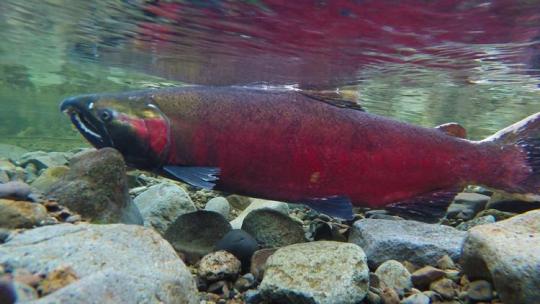
After exerting extreme amounts of energy travelling for hundreds of kilometers up rivers, fighting for nesting grounds, and finally reproducing, these fish die right after spawning. While doing so, they supply the river ecosystem with valuable resources: anadromous fishes are one of the only ways that nutrients can return back inland from the seas where they end up via water flow!
148 notes
·
View notes
Text
it's hilarious how jonny sim's naming history is making us doubt everything laid out in front of us
"what if john is just some other guy who works the day shift"
"alice and celia being anadromes could be unintentional"
"hilltop centre might just be a place with the same name as hilltop road"
the michaels bit was a strategy, we are doubting him and therefore doubting the truth
#to clarify i dont think it was actually a strategy#but it worked out pretty well huh#we're all so far in denial that reoccuring names literally mean nothing#the magnus protocol#tmagp#magnus protocol#the magnus pod#jon sims#alice dyer#celia ripley#hilltop road#hilltop centre
102 notes
·
View notes
Text
trout and salmon earrings for all of my freshwater fish girlies (gender-neutral) out there!! salmon are anadromous but still lol!! really really loved working on the coho salmons the most.
I’ve got an Etsy shop opening up by the end of this year with lots more fun fishy things to come! be on the look out for some saltwater fish earrings coming soon >:}
insta: @eel.mania <3
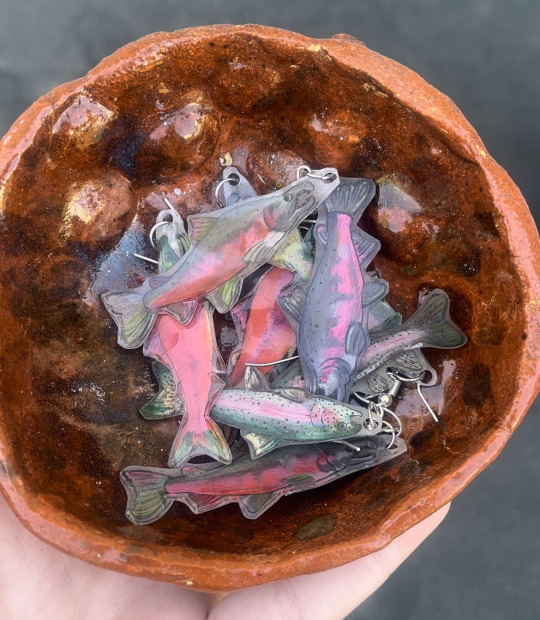
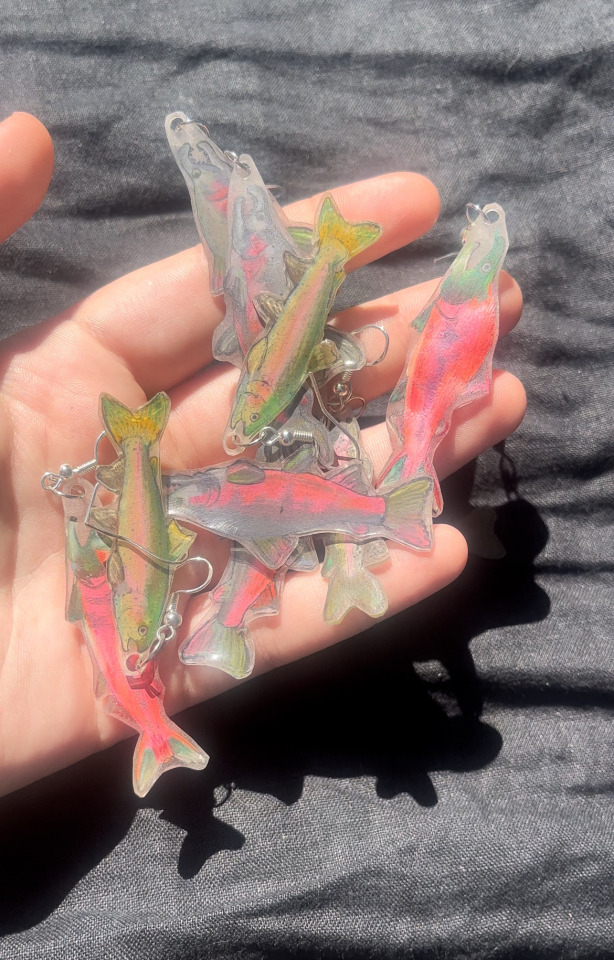
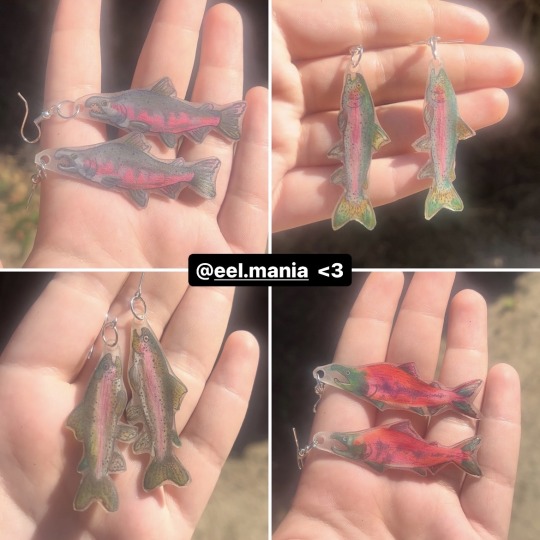
#salmon#rainbow trout#coho salmon#sockeye salmon#marine biology#marine bio#freshwater fish#fish#fish lover#etsyshop#etsyseller#small business#jewlery#there are many benefits to being a marine biologist#fishposting#queer artist#lgbtq artist#bony fish#fishblr#post#earrings#handmade#artists on etsy#etsyhandmade#fish enthusiast
126 notes
·
View notes
Text
For #FishyFriday:

“Shad” 373, from the ongoing search for all the animals from the 420 original 1906 Moravian tile mosaics by Henry Chapman Mercer on the Pennsylvania Capitol floor.
Shad (Alosinae) are native fishes with an anadromous migration similar to salmon. PA has two species: the American Shad (Alosa sapidissima) and the endangered Hickory Shad (Alosa mediocris).
#fish#shad#decorative arts#ceramics#tilework#mosaic#20th century art#1900s#American art#Pennsylvania art#Pennsylvania history#Pennsylvania capitol#Henry Chapman Mercer#Moravian Pottery and Tile Works#Fishy Friday#animals in art
340 notes
·
View notes
Text
Why Forests Need Salmon
(Originally posted at my blog at https://rebeccalexa.com/why-forests-need-salmon/)
One of my favorite fall activities is to check local streams for salmon runs. Here in the Pacific Northwest, and extending north into Alaska, we have seven species of anadromous Salmonidae: chinook salmon (Oncorhynchus tshawytscha), chum salmon (Oncorhynchus keta), coho salmon (Oncorhynchus kisutch), sockeye salmon (Oncorhynchus nerka), pink salmon (Oncorhynchus gorbuscha), coastal cutthroat trout (Oncorhynchus clarkii clarkii), and steelhead (Oncorhynchus mykiss). My favorite run is the chum salmon that run up Ellsworth Creek in southwest Washington each fall, but I’m honestly just happy to see any migrating salmon. And as I hike through stands of ancient western red cedar (Thuja plicata), I like to think about the many ways in which these and other forests need salmon for their ongoing health.
Anadromous fish are those that are born in fresh water, spend much of their adult lives in salt water, and then return to fresh water to spawn. Some, like Atlantic salmon (Salmo salar) and some populations of American shad (Alosa sapidissima) are iteroparous, meaning they can make this journey multiple times in a lifetime. Pacific salmonids, on the other hand, are semelparous, meaning that they spawn once and then die shortly thereafter. (From here on out I am going to use “salmon” as a general, casual term referring to both the Oncorhynchus species, and the steelhead and cutthroat trout.)
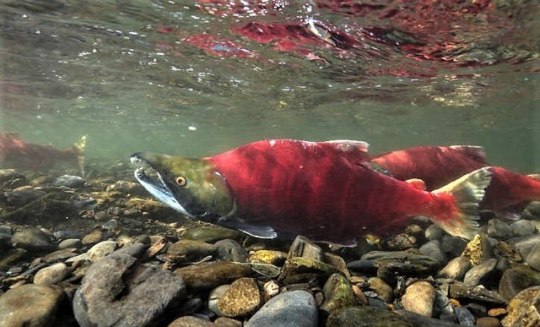
Pacific salmon were originally freshwater fish that inhabited lakes and slow-moving rivers. Somewhere around 25 million years ago, the climate cooled significantly, with average temperatures dropping almost twenty degrees F. We’re not sure at what point after this the salmon began expanding into brackish estuaries and then the Pacific Ocean itself, but when they did they found rich sources of food unlike what they had access to in fresh water. Over time, they evolved a life cycle that let them be born in the relatively safe shelter of freshwater streams, and then go out to the ocean to feast on the banquet found there when they were large enough to have a better chance of survival.
Eventually salmon runs could be found in streams as far inland as eastern Idaho, eastern British Columbia, and the southern two-thirds of Alaska (with some Alaskan runs even crossing over into Canada!) And until the arrival of European colonizers, these streams consistently provided indigenous people all along the Pacific coastline an incredibly important source of food, cultural and economic trade, mythos, and more. Unfortunately, the newcomers overharvested the salmon, dammed and destroyed streams and other habitat, and of course spearheaded the causes of anthropogenic climate change.

Indigenous people fish for salmon at Celilo Falls on the Columbia River. As the single longest continuously inhabited community in North America (over 15,000 years!), this location was a home and hub of cultural activity for many indigenous tribes and communities across the region before it was flooded by the completion of the Dalles Dam in 1957.
All these factors have led to a precipitous decline in the size of both salmon runs, and the salmon themselves. This isn’t just detrimental to indigenous communities, though. It also threatens the health of forests all throughout the salmons’ range.
A forest isn’t just made of trees. It’s composed of entire plant communities, fungi (including mycorrhizal species), and the animals, bacteria, and other living beings that share space with them. When salmon travel up and down the waterways as fry, and then later to spawn as adults, they have a direct impact on that ecosystem.
Salmon fry are an important source of food for larger fish, amphibians, birds, and other beings that seek food in the water. In fact, part of why salmon lay so many eggs (over 5,000 in the case of chinook!) is because most of the fry that hatch will never make it to adulthood. But adult salmon aren’t safe from predation on their return trip to their birthplaces. In fact, they are caught and eaten by a wide variety of animals from bears to eagles, wolves to osprey, sea lions to bobcats.
Bears are of particular interest here. Brown bears (Ursus arctos) are well-known for gorging on summer and fall salmon runs to build up massive amounts of fat in preparation for winter hibernation. (Katmai National Park even celebrates their bears during Fat Bear Week every October!) You can watch video feeds of several bears hanging out in their favorite fishing spots by waterfalls and in the flow of the river.
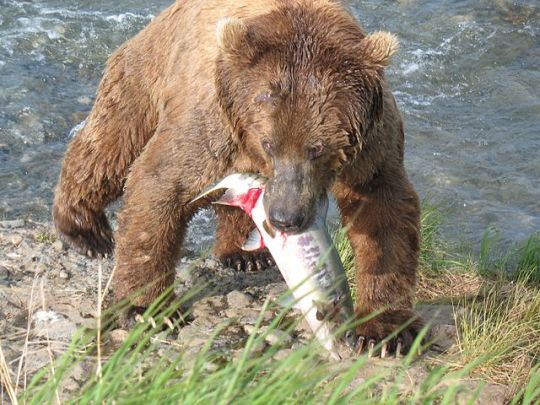
Imagine that you are a young bear, perhaps recently forced to independence by your mother who is now focused on your younger siblings. You have to not only start catching fish without her protection from bigger bears, but you also need to make sure those stronger bears don’t steal your catch. What’s the best thing to do? Run far away into the woods to eat your salmon in peace, then leave the remains among the trees and head back for more.
If the fishing is good, bears will often eat only the fattiest parts of the salmon like the brains and skin, and then leave the rest behind for scavengers. The nutrients in the salmon then disseminate throughout the forest, whether carried in the digestive systems of animals, or broken down in place by decomposers. This helps make the nutrients available to the plants, particularly trees which may store massive amounts of nutrients in their trunks; when the trees die, they essentially become a food pantry for younger beings like new seedlings, fungi, and so forth.
Now–what’s so special about the nutrients in salmon? Well, remember that these fish spend years out in the ocean. And the ocean has an entirely different balance of nutrients floating around in it compared to what’s found in fresh water or on land. The salmon are essentially the only way these ocean-borne nutrients can make their way into the forest in any meaningful amount, and they do so on a regular basis each year. The trees near salmon runs fished by bears may be 300% larger than usual, and salmon also provide nearly three quarters of the nitrogen in the forest. That’s a pretty impressive contribution!

This isn’t just about how forests need salmon; it’s a reciprocal relationship. While the salmon’s immediate habitats are aquatic, these streams, rivers, and other waterways are directly affected by what happens on the land around them.
Every waterway has a watershed–an area of land from which precipitation drains into that waterway. These watersheds nest within each other; the watersheds of small streams are nested within the watersheds of the rivers the streams feed into. That water carries things with it, from soil to pollutants. So the health of the land has a direct impact on what is found in the water.
But it goes beyond what’s washed downstream, and into how it’s washed down. In a healthy forest, for example, the soil is able to absorb a significant amount of precipitation that falls throughout the year, keeping it from simply cascading down hillsides to create flooding and landslides. Water is also stored in the various living beings in the forest; again trees are often the champions with their great size, but smaller plants help with water retention quite a bit as well, both through internal storage and preventing evaporation from soil. A forest that is badly damaged, such as through a clearcut or wildfire, won’t hold water as well. This can lead to floods, landslides and other erosion, and increase the impact of summer droughts as the land simply can’t store as much water, or for as long.
All of this affects the salmon directly. If the watershed is no longer holding and releasing snowmelt, rain, and other water in a controlled manner, this can lead to flooding in waterways which can wash away salmon eggs and fry. Increased erosion buries the gravel that salmon lay eggs in with silt, smothering the eggs so they never hatch. When a riparian zone–the land along a waterway–is stripped of vegetation, the water loses crucial shaded areas that keep temperatures cool. Salmon easily overheat when temperatures rise even a few degrees. And drought can dry up smaller streams, stranding and even killing young salmon while preventing adults from reaching their spawning grounds.
While not every single salmon run exclusively travels through forests, many of them do. And many spawning grounds are found in forests, or at least areas with significant tree cover in riparian zones. Salmon must have healthy forests in order to continue to survive, and the loss of these forests is just one of many factors contributing to their severe decline.
Thankfully, I am far from the only person concerned about the safety of our wild Pacific salmon. There are numerous organizations working to protect and restore salmon habitat through dam removal, preservation and restoration of aquatic habitat and surrounding land, regulations on salmon fishing, and educating people about sustainable seafood options (or just not eating seafood at all.) And even habitat restoration efforts that aren’t directly in salmon-inhabited waterways still have a positive impact on the forest ecosystem as a whole.
We know that forests need salmon, and salmon need forests. To protect one is to protect the other, and long may they both thrive.
Did you enjoy this post? Consider taking one of my online foraging and natural history classes, checking out my other articles, or picking up a paperback or ebook I’ve written! You can even buy me a coffee here!
#long post#salmon#fish#forests#nature#ecology#science#science communication#scicomm#wildlife#bears#Pacific Northwest#PNW#ecosystems#biology#extinction#endangered species#conservation#environment#environmentalism
608 notes
·
View notes
Text
Okay, mis petite amores, today’s fish is a little less flashy, but still - they glow. In this post you will learn about fish candles, overland grease trails, and a theory on the state of Oregon.
I would like to introduce you to Thaleichthyes pacificus, also known as the eulachon (you-luh-con, in the lower 48; hooligan in Alaska; oolighan in Chinook Jargon)Also known as the candlefish.
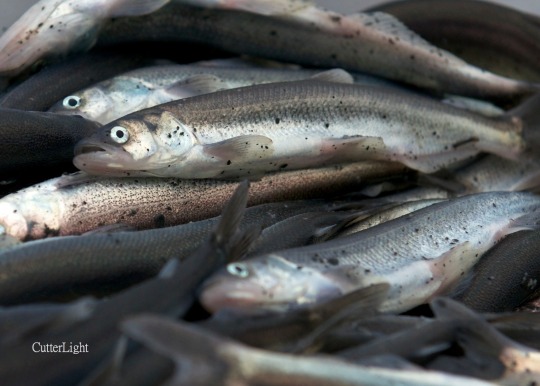
These are tiny smelt - but they are also extremely fatty fish.
With up to 15% of their body weigh being fat tissue, if you dry one out and string it on a wick, YOU CAN LITERALLY BURN IT LIKE A CANDLE.
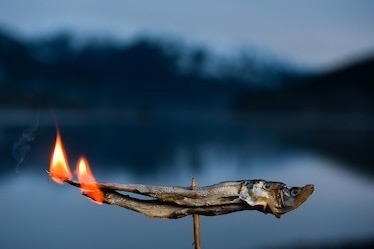
They’re anadromous, like salmon, so they live in the ocean during most of their lives but spawn in freshwater rivers - though they’re rather less predictable.

Indigenous communities on North America’s Pacific coast included eulachon as part of their diet, and often processed them for oil - which is done by letting them rot in a hole in the ground for about a week before adding boiling water and skimming the oil off the top.
Eulachon oil was so widely traded between coastal tribes and inland tribes that the trade routes were called grease trails.
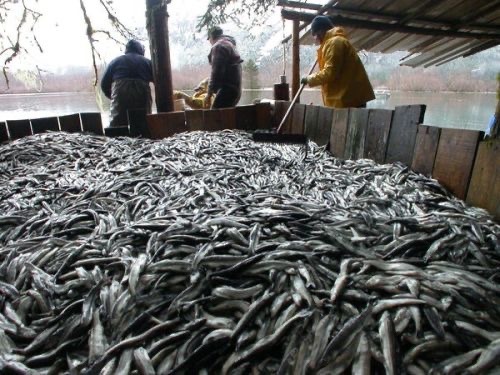
In fact, one archaeologist argued in a paper that the name of the state of Oregon was derived from the Chinook Jargon word - oolighan.

A few distinct population segments of eulachon are threatened or endangered, so at this point I would not in good conscience recommend setting any on fire.
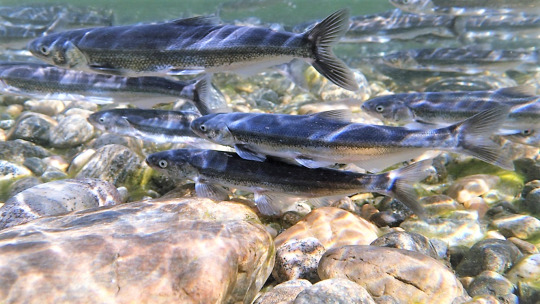
87 notes
·
View notes
Note
can u do nurse shark. or if ur into fish sturgeon plssss
i made a post about nurse sharks a while back and you can find that here, but of course i will talk about sturgeon

there are around 27 known species of sturgeon. they are one of the most ancient types of fish that are still alive today (they lived at the same time as dinosaurs!!), and unfortunately they are considered some of the most endangered species and are at risk of extinction.
- the average lifespan of a sturgeon is 50-60 years, but some of them live to be over 100 years old.
- some species of sturgeon are strictly freshwater fish, but some are anadromous, meaning they spend most of their lives in saltwater but migrate to freshwater to spawn. some sturgeon even travel over 100 miles to get to their spawning grounds.
- baby sturgeon have teeth, but as they mature they lose their teeth. adult sturgeon will suck up their prey through their mouths and expel any extra debris out through their gills. they were one of the first types of fish to develop this "sucking" style of eating! much like most other bottom dwellers, sturgeons also have barbels to help them detect their prey.
32 notes
·
View notes
Text
Salmonids of Artechocene Antarctica:
While thawing, the glaciers of Antarctica created an abundance of meltwater streams that now feed countless kilometres of freshwater ecosystems. At first nothing more than insect larvae and some crustaceans called these new environments home, but eventually fish entered the equation and quickly dominated.
One group of these fish were salmonids coming from South American coasts, descendants of invasive species such as the brown trout. They weren't the first, but they were much better at filling a lot of niches than the native Nothotenioids, which lacked hemoglobin and swim bladders.
And so they almost outcompeted these to extinction, and diversified into several genera classified roughly in three distinct groups: Helaks, Helerrets, and Valhallaks.

Most of the Helaks species are amongst the largest predators of the continent, and the Golden Helaks (Gjollsalmo fulgens) is the largest of them all, measuring up to 2 meters (7ft) long and more than 100kg (250lb) in weight. They're apex predators, using their size to block scape routes for prey fish of any size and swallowing them whole, preventing them from scaping thanks to its huge backwards facing teeth. They're also known to eat crustaceans and even birds that venture too deep into the water. They live in every waterway across Antarctica, with the adults being confined to the deeper canals and lakes.
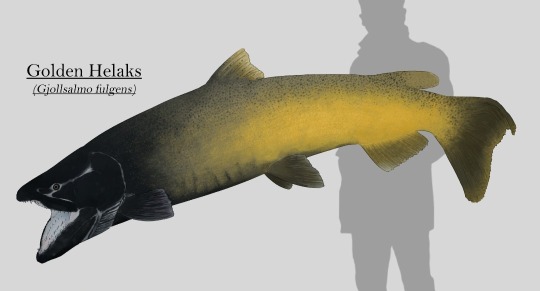
Helerrets are the most common salmonids that can be found in the rivers, lakes and wetlands of the continent. These medium sized predators mainly feed on the abundance of mollusks and other hard shelled invertebrates, as well as smaller vertebrates occasionally. This diet is enabled by their strong jaws, combined with blunt teeth that can crack open the shells of most freshwater invertebrates in their habitats. They're also the only Antarctic salmonids that retain the anadromous habits of its ancestors, living in freshwater but migrating to coastal waters to reproduce and release their young into the rich waters of the Southern Ocean.
The Bullheart Helerret (Slidrsalmo oatensis) in particular is native to the drainage basins that flow into Oates bay, where members of this species comes to spawn.
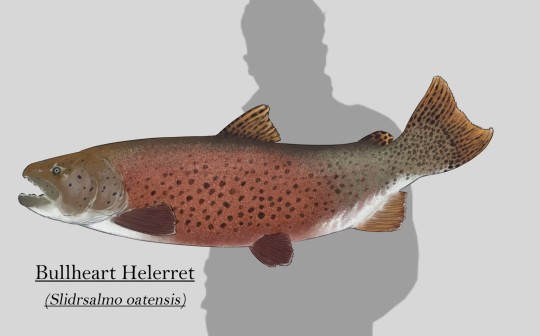
Valhallaks are a group of salmonids with remarkable sexual dimorphism compared to their close relatives. They are typically found in shallow rivers all across the continent, where they feed on invertebrates and vegetation.
Although not as common as Helerrets, they are abundant, specially in alpine streams and lakes during the end of the summer, where they come to spawn, away from predators so their eggs are protected by ice during the winter.
The Bearded Valhallaks (Valholsalmo auratops) specifically is endemic to the Vostok river drainage basin, which originates in Vostok Lake where they reproduce.
Range of the species featured:
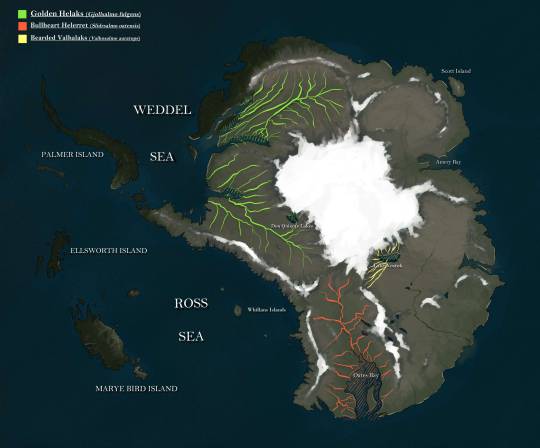

67 notes
·
View notes
Text
temprate stream dashboard simulator

🌊Smexy_eel_lady Follow
selfie from my new apartment! I found a lovely rock somehow in my budget and I'm f(eel)ing so lucky!

#finally made it
♻️ 🪱detritus_luvr Follow
Enough with that, TELL US HOW YOU FUCK

🐸 flychomper Follow
I can't believe how many of my logmates haven't heard of/seen BROOKlyn 99, do they all live under a rock?
♻️ 🦞benTHICCC-biome Follow
I can't stand this, it's 2024 and people on this wetsite still use "live under a rock" as an insult. I can't fucking even, do you know how disenfranchising it is to hear people talk with scorn about the way you and your family have lived for generations? go dry out, sir.
♻️ 🪷lowflowvegetation Follow
reblogging bcs important, but also please don't tell people to dry themselves out!

🐟deepchannelfan Follow
callout post for @smoothturtleleech I have no issue with parasitism, but have any of you noticed how turtleleech \only\ parasitizes turtles? kinda problematic imo.
#calloutpost
♻️ 🐢smoothturtleleech Follow
I also parasitized your mom last night lol

🐠riverartist Follow
Art and artist! Really happy with how this one came out! took me about 10 hrs to get the pebbles together and assemble them.

#artistsontumblr #sculpture #pebblework
♻️🐍nerodiaaa Follow
wtf that's so cool! lmk if you take commissions
♻️🦎sal-the-mander Follow
going to make this my streamsaver
#the highest quality content on this horrible wetsite

🐟salmonidayyyy Follow
I love you catadromous fishes I love you anadromous fishes I love you migrants. Never let anyone tell you that you aren't stream fauna bcs you haven't spent your whole life in the stream or weren't born here {flaps you with my fins]
♻️🛶virgeon-sturgeon Follow
Thanks bro, I really needed to hear that, {flaps you with my fins].

🐚riffleranger Follow
MMMMMM I WANNA LAY ALL MY EGGS IN THESE PEBBLES, SUCH GOOD PEBBLES I LOVE THESE PEBBLES.
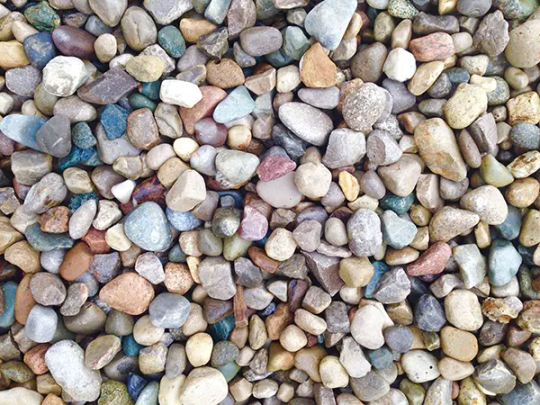
♻️🐌algaegrazer Follow
@riffleranger this U?
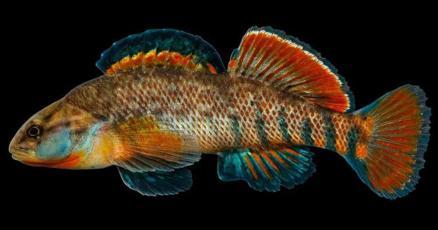
♻️🐚riffleranger OP Follow
I should be offended, but yes, I am her, she is me
♻️🐚riffleranger OP Follow
OH WAIT, OH SHIT THAT IS ME WHERE DID YOU GET THAT PHOTO????
21 notes
·
View notes
Text

My final piece for the 2022 Sea Unseen zine, featuring a sockeye salmon!
Sockeye salmon are anadromous, meaning they hatch in freshwater, migrate to the ocean for most of their adult life, and then finally at the end of their lives return to the rivers they hatched in so that they can spawn. There's a river near my childhood home that was a salmon run and every fall I would spend hours watching these beautiful fish force their way upstream.
296 notes
·
View notes
